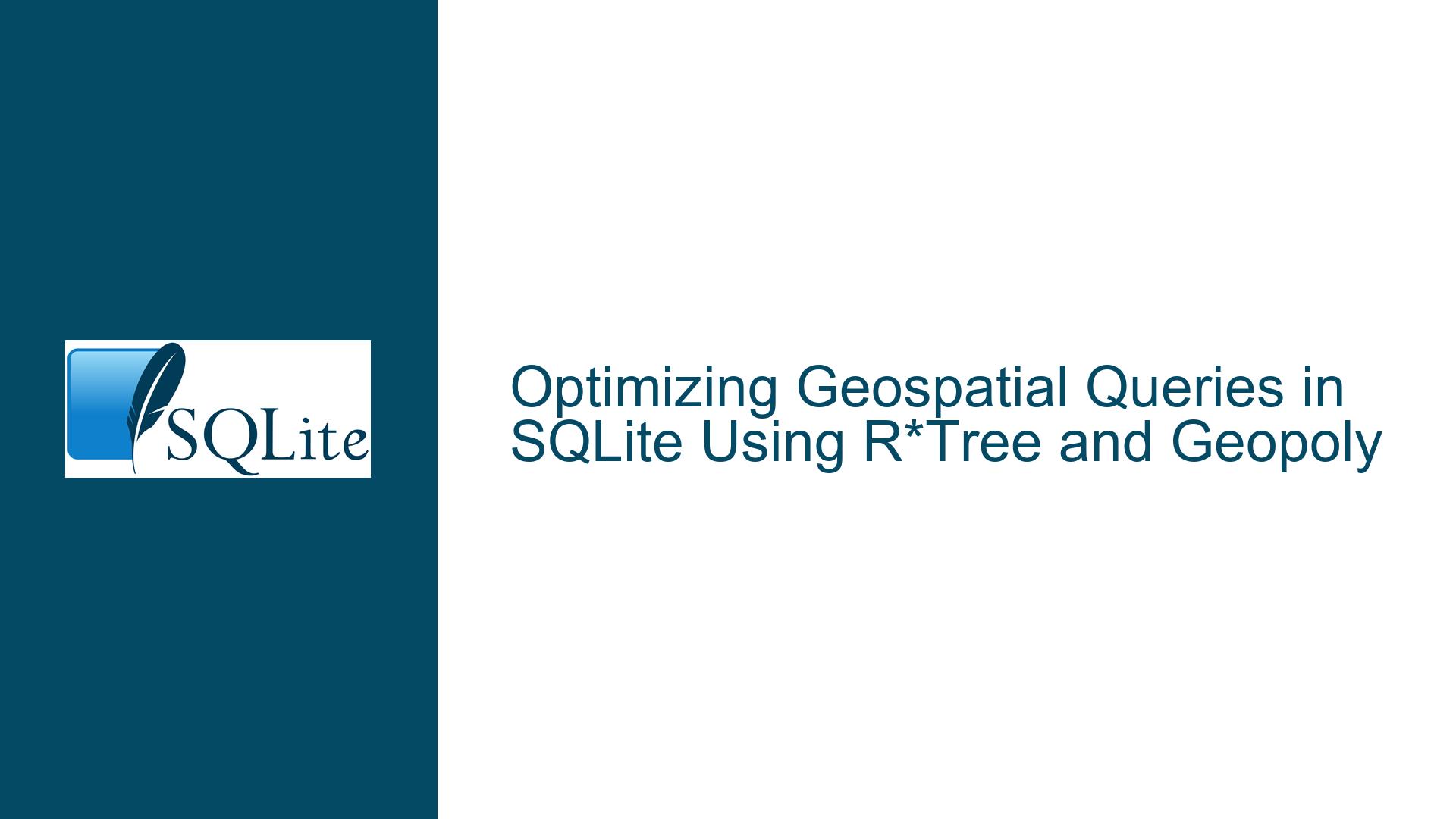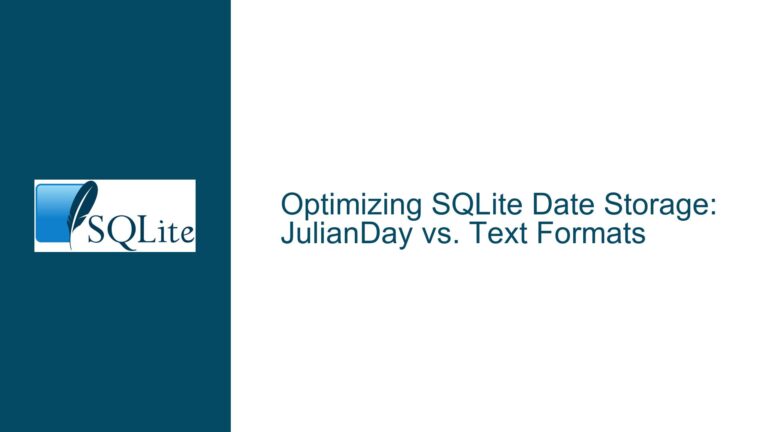Optimizing Geospatial Queries in SQLite Using R*Tree and Geopoly
Understanding Geospatial Data Handling in SQLite with R*Tree and Geopoly
SQLite’s RTree and Geopoly extensions provide specialized tools for managing spatial data, but their implementation requires a nuanced understanding of their capabilities, limitations, and interaction with SQLite’s core engine. The RTree module is designed for efficient spatial indexing of multi-dimensional data, making it ideal for bounding-box-based searches (e.g., "find all points within a rectangular area"). Geopoly, introduced in SQLite 3.34.0, extends this functionality by supporting polygon-based operations, including containment checks and polygon overlap detection using the Geopoly JSON format.
When storing point data (e.g., latitude/longitude coordinates), developers often face tradeoffs between simplicity and performance. The RTree module requires defining a virtual table with integer or real-valued dimensions, while Geopoly operates on polygon vertices stored as JSON arrays. For point data, RTree is typically sufficient, but Geopoly can offer advantages when querying complex regions or performing polygon-to-point containment tests. A common oversight is assuming these modules behave identically to full-fledged GIS databases like PostGIS; while they are lightweight and embeddable, they lack advanced spatial functions (e.g., distance calculations, spatial joins) without custom extensions.
Key differences between R*Tree and Geopoly:
- Indexing Strategy: R*Tree uses a hierarchical tree structure to partition spatial data, optimizing range queries. Geopoly encodes polygons using the s2 library’s hierarchical triangular mesh for Earth-scale coordinates.
- Data Representation: R*Tree requires fixed-dimensional columns (e.g.,
minX, maxX, minY, maxYfor 2D points). Geopoly stores polygons as JSON arrays of vertex coordinates, enabling arbitrary shapes. - Query Flexibility: R*Tree excels at rectangular range queries. Geopoly supports
geopoly_within(),geopoly_overlap(), andgeopoly_bbox()for complex spatial relationships.
For point data, a typical R*Tree schema might look like:
CREATE VIRTUAL TABLE points_rtree USING rtree(
id, -- Integer primary key
minX, maxX, -- Bounding box for X (e.g., longitude)
minY, maxY -- Bounding box for Y (e.g., latitude)
);
Points are inserted by setting minX = maxX and minY = maxY. Queries for points within a bounding box become straightforward:
SELECT id FROM points_rtree
WHERE maxX >= ?minLon AND minX <= ?maxLon
AND maxY >= ?minLat AND minY <= ?maxLat;
Geopoly, on the other hand, represents points as degenerate polygons with identical vertices:
INSERT INTO geopoly_data (id, polygon)
VALUES (1, '[[-73.935242, 40.730610, 0], [-73.935242, 40.730610, 0]]');
Containment queries use geopoly_within():
SELECT id FROM geopoly_data
WHERE geopoly_within(polygon, ?search_polygon);
A critical nuance is coordinate ordering: SQLite’s R*Tree and Geopoly use Cartesian coordinates by default, which can lead to inaccuracies when working with geographic coordinates (latitude/longitude) due to Earth’s curvature. Developers must decide whether to project coordinates into a planar system or accept minor errors for small-scale applications.
Common Challenges in Implementing R*Tree and Geopoly for Point Data
Schema Misconfiguration
- R*Tree Column Mismatch: Defining an R*Tree table with fewer/more dimensions than required (e.g., omitting
minY/maxYfor 2D data) will cause insertion errors or incomplete spatial indexing. - Geopoly JSON Format Errors: Invalid JSON structures (e.g., missing vertices, incorrect nesting) in Geopoly columns will silently fail queries or return incorrect results.
- R*Tree Column Mismatch: Defining an R*Tree table with fewer/more dimensions than required (e.g., omitting
Query Performance Degradation
- Unoptimized Bounding Boxes: Overly large bounding boxes in R*Tree queries (e.g., searching an entire continent for a city-level point) negate the benefits of spatial indexing.
- Polygon Complexity in Geopoly: Polygons with hundreds of vertices incur computational overhead during containment checks, especially when comparing multiple polygons.
Coordinate System Assumptions
- Latitude/Longitude as Cartesian Coordinates: Treating geographic coordinates as planar values introduces distortion. For example, a 1-degree longitude span near the equator (~111 km) shrinks toward the poles.
- Unhandled Wrapping at Antimeridian: Points near longitude ±180° may be misindexed if the R*Tree or Geopoly implementation does not account for coordinate wrapping.
Extension Loading Issues
- Missing Compilation Flags: The R*Tree module is included in the SQLite amalgamation by default, but Geopoly requires
-DSQLITE_ENABLE_GEOPOLYduring compilation. Precompiled binaries (e.g., those used bynode-sqlite3) may lack Geopoly support. - Runtime Loading Failures: Attempting to load Geopoly as a runtime extension without enabling
SQLITE_DBCONFIG_ENABLE_LOAD_EXTENSIONcan cause crashes in environments like Node.js.
- Missing Compilation Flags: The R*Tree module is included in the SQLite amalgamation by default, but Geopoly requires
Concurrency and Transaction Conflicts
- Write-Ahead Logging (WAL) Limitations: R*Tree tables do not support
WITHOUT ROWID, complicating concurrent write-heavy workloads. - Geopoly Index Locking: Geopoly’s reliance on auxiliary tables for indexing can lead to table-level locks during updates.
- Write-Ahead Logging (WAL) Limitations: R*Tree tables do not support
Best Practices for Efficient Geospatial Indexing and Query Optimization
Step 1: Schema Design and Data Ingestion
R*Tree for High-Volume Point Data: Use R*Tree when dealing with millions of points requiring fast bounding-box lookups. Ensure the schema matches the coordinate dimensions:
CREATE VIRTUAL TABLE points USING rtree( id, minLon, maxLon, -- Longitude bounds minLat, maxLat -- Latitude bounds );Insert points by setting
minLon = maxLonandminLat = maxLat.Geopoly for Hybrid Point-Polygon Workloads: If your application requires both point-in-polygon and polygon-overlap queries, use Geopoly with a unified schema:
CREATE TABLE geospatial_data ( id INTEGER PRIMARY KEY, type TEXT CHECK(type IN ('point', 'polygon')), boundary TEXT -- Geopoly JSON for polygons, degenerate JSON for points );Batch Inserts with Transactions: For bulk data ingestion, wrap inserts in transactions to minimize I/O overhead:
// Node.js example using better-sqlite3 const insert = db.prepare('INSERT INTO points VALUES (?, ?, ?, ?, ?)'); db.transaction(() => { for (const point of points) { insert.run(point.id, point.lon, point.lon, point.lat, point.lat); } })();
Step 2: Query Optimization Techniques
Constraint Pushdown in R*Tree: Leverage SQLite’s ability to optimize queries by structuring WHERE clauses to use indexed columns first:
-- Efficient: Constraints on maxLon/minLon leverage the R*Tree index SELECT id FROM points WHERE maxLon >= -74.259090 AND minLon <= -73.700272 AND maxLat >= 40.477399 AND minLat <= 40.917577; -- Inefficient: Additional non-spatial filters applied too early SELECT id FROM points WHERE (maxLon >= -74.259090 AND minLon <= -73.700272) AND (maxLat >= 40.477399 AND minLat <= 40.917577) AND some_unindexed_column = 'value'; -- Degrades performanceGeopoly Indexing with Auxiliary Tables: Speed up polygon containment queries by maintaining a bounding box column indexed via R*Tree:
CREATE VIRTUAL TABLE geopoly_bbox USING rtree( id, minX, maxX, minY, maxY );Populate the bounding box using
geopoly_bbox():INSERT INTO geopoly_bbox (id, minX, maxX, minY, maxY) SELECT id, bbox->>'x0', bbox->>'x1', bbox->>'y0', bbox->>'y1' FROM ( SELECT id, json_extract(geopoly_bbox(polygon), '$') AS bbox FROM geopoly_data );Query using a two-stage filter:
SELECT g.id FROM geopoly_data g JOIN geopoly_bbox b ON g.id = b.id WHERE b.maxX >= ?x0 AND b.minX <= ?x1 AND b.maxY >= ?y0 AND b.minY <= ?y1 -- Fast R*Tree filter AND geopoly_within(g.polygon, ?search_polygon); -- Precise Geopoly check
Step 3: Handling Coordinate Systems and Precision
- Normalize Geographic Coordinates: If using latitude/longitude, pre-project coordinates to a local coordinate system (e.g., UTM) for small-scale applications to minimize distortion.
- Mitigate Antimeridian Issues: For global datasets, split geometries crossing the antimeridian (longitude ±180°) into contiguous segments.
Step 4: Extension Management in Node.js
Recompile SQLite with Geopoly Support: When using
node-sqlite3, replace the default SQLite library with a custom build:npm rebuild sqlite3 --build-from-source --sqlite=/path/to/custom/sqlite3.amalgamationEnsure the amalgamation includes
-DSQLITE_ENABLE_GEOPOLY.Load Extensions Securely: Enable extension loading and load Geopoly at runtime:
const db = new sqlite3.Database(':memory:'); db.configure('extensionLoading', true); db.loadExtension('./geopoly');
Step 5: Concurrency and Scaling
- Partition Data with Sharding: Split large datasets into sharded tables (e.g.,
points_east,points_west) based on geographic regions to reduce lock contention. - Use WAL Mode Judiciously: Enable Write-Ahead Logging for concurrent reads/writes, but monitor performance as R*Tree updates can fragment the WAL file.
Step 6: Validation and Debugging
Verify Index Usage with EXPLAIN QUERY PLAN: Confirm that queries utilize R*Tree/Geopoly indexes:
EXPLAIN QUERY PLAN SELECT id FROM points WHERE maxLon >= -74.259090 AND minLon <= -73.700272;Look for
SCAN TABLE points VIRTUAL TABLE INDEX 2:...in the output.Cross-Check with Geohashing: For critical applications, validate results using an independent geohashing library (e.g.,
ngeohash) to ensure spatial logic correctness.
By adhering to these practices, developers can harness SQLite’s spatial extensions for efficient point data management while avoiding common pitfalls in schema design, query optimization, and system integration.






